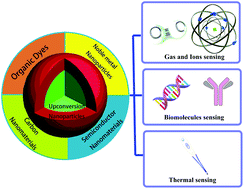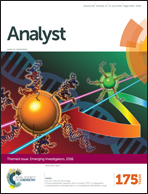Bioapplications and biotechnologies of upconversion nanoparticle-based nanosensors
Abstract
Upconversion nanoparticles (UCNPs), which can emit ultraviolet/visible (UV/Vis) light under near-infrared (NIR) excitation, are regarded as a new generation of nanoprobes because of their unique optical properties, including a virtually zero auto-fluorescence background for the improved signal-to-noise ratio, narrow emission bandwidths and high resistance to photo-bleaching. These properties make UCNPs promising candidates as luminescent bioprobes in biomedicine and biotechnology. In this review, we focus on the recent progress in the development of UCNP-based nanoprobes for biosensing. Firstly, as the FRET process is a widely used method for biosensing to improve the sensitivity, we summarize recent research studies about UCNP-based nanocomposites utilizing the FRET process for biosensing. Different energy acceptors (organic dyes, noble metal nanoparticles, carbon nanomaterials and semiconductor nanomaterials) with their own advantages and limitations are well summarized in this review. Secondly, since UCNPs have been utilized for the detection of different kinds of analytes, we introduce recent research studies about UCNPs for ions, gas molecules, biomolecules and thermal sensing. Finally, we highlight the typical detection techniques and UCNP based devices for bioapplications.

- This article is part of the themed collection: Emerging Investigators

 Please wait while we load your content...
Please wait while we load your content...